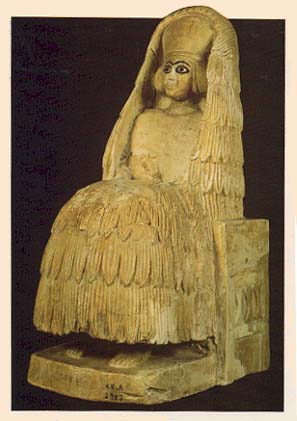Image Details

Lorenzo de Masi/Sites
Votive statue of a seated female worshipper. Found in the temple of Ishtarat at Mari, this wide-eyed female figure was just one of dozens that lined the walls of the fertility goddess’s temple. Situated on the middle Euphrates River, the powerful and wealthy city of Mari vied with Ebla for control of trade routes through central Syria in the third and second millennia B.C.
A so-called kaunakes garment—a tufted, tasseled robe that may have been woven to resemble a sheep’s fleece—covers most of the woman’s body. Her headdress, the large derby-like hat with a rolled-up brim, is called a polos.
Most such votive statues were small—this one stands only 13.5 inches high—and were inscribed with dedicatory prayers for a long life for the donor and the donor’s ruler.
